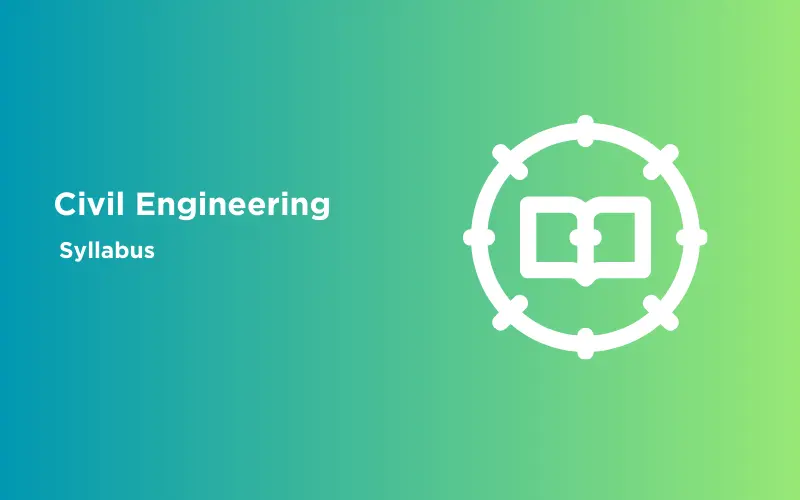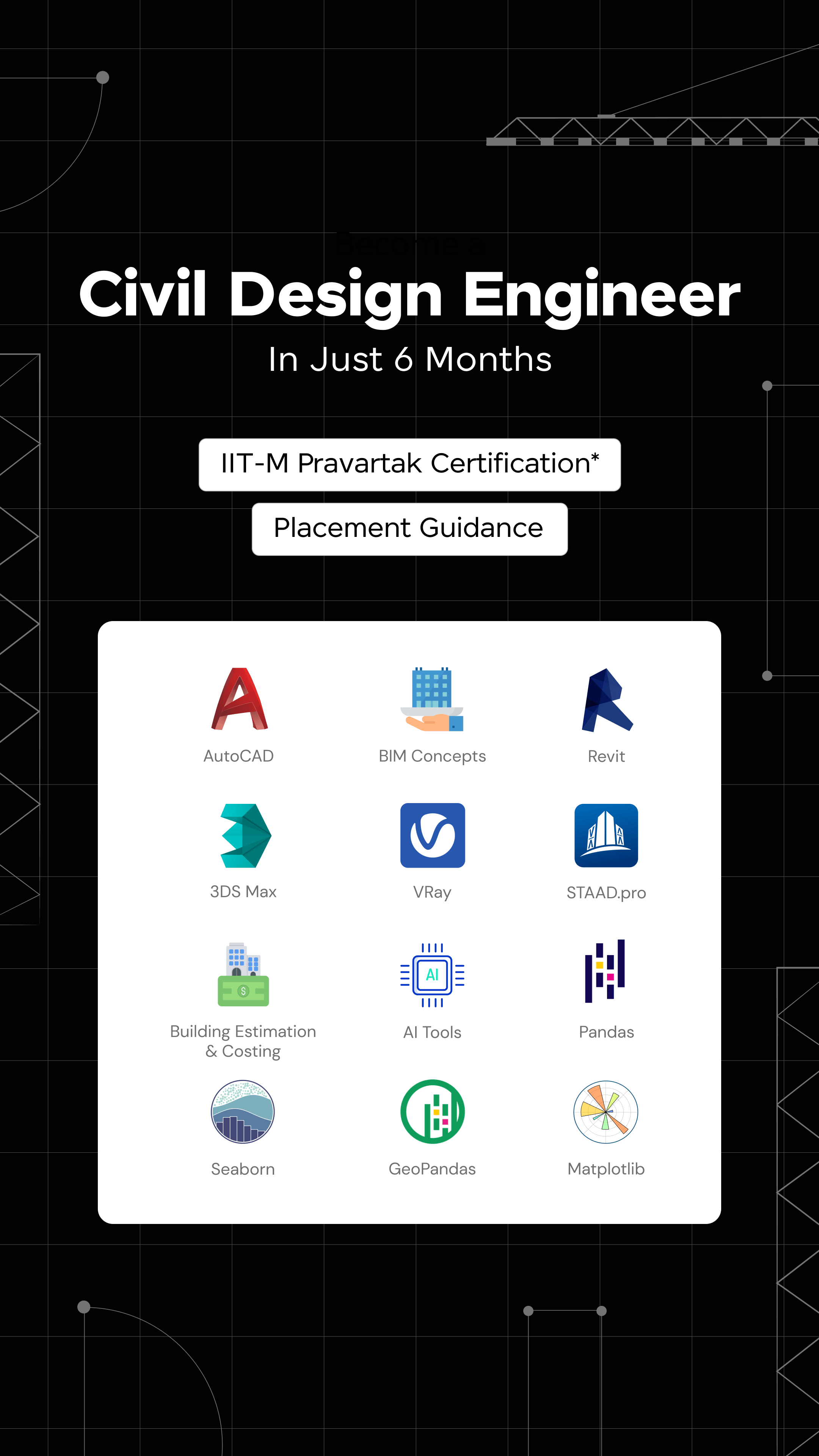
Profound Look On The Civil Engineering Syllabus | 2025
Mar 29, 2025 10 Min Read 4378 Views
(Last Updated)
There’s a famous saying “Plan before you leap” that generally means that you have to plan out things before acting toward them. In the same way, a syllabus is something that helps you plan about the subject beforehand. In accordance with that, we came up with the civil engineering syllabus that might help you set a career in civil engineering.
We don’t want you to ponder too much about the things that you going to face when you take up civil engineering and that’s why we came up with this idea of presenting to you, the civil engineering syllabus that has all the things that you need to know in order to prepare yourself.
In this article, you will learn what civil engineering is all about, how it is shaping up our world, and most importantly the civil engineering syllabus that you must know. So, without further ado, let’s get started.
Table of contents
- What is Civil Engineering?
- Civil Engineering Syllabus 2025
- Mathematics and Basic Sciences
- Core Engineering Courses
- Elective Courses (Specializations)
- Laboratories and Practical Work
- Design Projects:
- Codes and Standards
- Computer-Aided Design (CAD) and Software Tools
- Ethics and Professional Practice:
- Conclusion
- FAQ
- What are the core subjects in the civil engineering syllabus?
- Do I need to study computer software and tools in civil engineering?
- Are there opportunities to work on real construction sites as part of the syllabus?
- How long does it take to complete the civil engineering syllabus?
What is Civil Engineering?

Before we start digging deep into the civil engineering syllabus, let’s first understand what civil engineering is all about, and why it is considered to be an important field in the modern age.
Civil engineering is a branch of engineering that focuses on designing, building, and maintaining the infrastructure and structures that make up our everyday environment.
This includes things like roads, bridges, buildings, dams, airports, and water supply systems. Civil engineers use their expertise to ensure these structures are safe, functional, and sustainable.
They consider various factors like materials, environmental impact, and cost to create solutions that improve the quality of life for people in communities around the world.
Civil engineering plays a vital role in shaping the physical world we live in. It’s about creating the foundations for modern society by planning, designing, and overseeing the construction of essential structures and systems that help people live, work, and travel efficiently and safely.
Whether it’s designing a new skyscraper, a transportation network, or a clean water supply, civil engineers work to make our world more accessible, resilient, and environmentally friendly.
Before we move into the next section, we’d like to ensure you are well-versed in the essentials of civil engineering. To smoothen your learning process, consider enrolling in GUVI’s Civil Engineering Career Program with Placement Assistance. You’ll gain hands-on knowledge of fundamental tools such as AutoCAD, Revit, 3dsMax, etc, needed for modern civil design.
Additionally, if you want to get started in the field through self-paced learning, try GUVI’s self-paced AutoCAD certification course.
Civil Engineering Syllabus 2025

A civil engineering syllabus typically covers subjects such as mathematics, physics, and so on. Apart from this, it also comprises various engineering disciplines that have to be understood in order to become a successful civil engineer. So let’s understand them one by one.
1. Mathematics and Basic Sciences
Mathematics and basic sciences are fundamental subjects in civil engineering that provide the essential building blocks for understanding and solving engineering problems. Let me explain them in simpler terms:
1. Mathematics:
Mathematics is like the language of engineering. It helps civil engineers describe and solve various problems they encounter in their work. Here’s why math is important in the civil engineering syllabus:
- Calculus: This helps in understanding how things change. For example, it’s used to calculate how water flows in rivers, how buildings settle over time, or how forces affect structures during an earthquake.
- Algebra and Geometry: These are used for calculations and measurements in construction and design. Engineers use algebra to solve equations and geometry to work with shapes and angles.
- Statistics: Engineers use statistics to analyze data and make informed decisions. For instance, they might use statistics to predict how much traffic a bridge can handle based on past data.
- Differential Equations: These are used to model complex processes in civil engineering, like how heat flows through materials or how water moves through soil.
2. Basic Sciences:
Basic sciences like physics and chemistry provide the scientific principles that are crucial in the civil engineering syllabus. Here’s how they’re applied:
- Physics: Engineers use physics to understand how forces, motion, and energy work. For example, when designing a bridge, they need to know how different forces like weight and wind affect the structure’s stability.
- Chemistry: Understanding chemistry is important for dealing with materials like concrete, steel, and soil. Engineers need to know how these materials react under different conditions to ensure the safety and durability of structures.
Think of math and basic sciences as the toolbox that civil engineers use to analyze and solve problems. Whether it’s designing a skyscraper, planning a road, or managing water resources, these subjects provide the knowledge and tools needed to make informed decisions and create safe and efficient infrastructure.
2. Core Engineering Courses
The heart of your education in this field is core engineering courses in the civil engineering syllabus. They teach you the essential knowledge and skills needed to work as a civil engineer. Let’s break down what these courses involve in simple terms:
1. Engineering Mechanics:
This course helps you understand how things move and interact with each other. Imagine you’re building a bridge. You need to know how different forces (like the weight of the bridge and the forces of vehicles passing over it) affect the bridge’s stability. Engineering mechanics teaches you these concepts so you can design structures that stay strong and safe.
2. Statics and Dynamics:
Statics deals with objects that aren’t moving, while dynamics focuses on objects in motion. In civil engineering, you’ll learn how to analyze and calculate the forces acting on structures that are both stationary (like a building) and in motion (like a bridge with vehicles crossing it). This knowledge helps ensure that buildings and bridges can handle the forces they encounter.
3. Strength of Materials:
This course is all about understanding how materials like steel, concrete, and wood behave under different loads (forces). It’s crucial because you need to know how strong materials are to design structures that can withstand various conditions, such as heavy loads or strong winds.
4. Fluid Mechanics:
Fluid mechanics is about how liquids (like water) and gases (like air) behave and flow. In civil engineering, you’ll use this knowledge to design systems for moving and managing fluids, such as water supply networks or drainage systems.
5. Structural Analysis:
This course helps you understand how structures, like buildings and bridges, distribute and bear loads. Think of it as figuring out how different parts of a structure work together to support everything on top of it. It’s like solving a puzzle to make sure a building or bridge stays stable.
6. Geotechnical Engineering (Soil Mechanics and Foundation Engineering):
Civil engineers need to know about the ground (soil) because it’s what supports everything we build. This course teaches you how to assess soil properties, like its strength and stability, to design safe foundations for structures like buildings and bridges.
7. Hydraulics and Hydrology:
Hydraulics is the study of how fluids flow, while hydrology is about understanding water in the environment. You’ll learn how to design systems for managing water, such as dams, flood control measures, and water supply networks.
8. Surveying and Geomatics:
Surveying involves measuring and mapping land, which is crucial for planning and designing construction projects accurately. Geomatics combines surveying with technology like GPS to collect and analyze data about the Earth’s surface.
9. Construction Management and Project Planning:
This course covers the principles of managing construction projects, including budgeting, scheduling, and ensuring that work is completed safely and efficiently.
These core courses provide the foundation for your civil engineering education. They equip you with the knowledge and skills to design, build, and maintain the infrastructure that keeps our cities and communities functioning safely and efficiently.
3. Elective Courses (Specializations)
Elective courses in civil engineering syllabus allow students to choose specific areas of focus or specialization within the field. These courses give students the opportunity to dive deeper into topics they are particularly interested in or plan to pursue as a career.
Here are some common specializations in the civil engineering syllabus and what they involve:
1. Traffic Engineering:
This specialization focuses on designing and managing traffic systems. Think of it as making sure roads and intersections work smoothly, helping people get from one place to another efficiently and safely.
2. Water Resources Engineering:
In this area, you learn how to manage water wisely. You might work on projects related to water supply, flood control, or protecting water quality in rivers and lakes.
3. Geospatial Engineering:
This specialization combines civil engineering with advanced mapping technology. It’s like creating detailed maps and 3D models of the Earth’s surface for various purposes, like urban planning or environmental monitoring.
4. Environmental Impact Assessment:
This involves studying how construction projects affect the environment and finding ways to minimize their impact. It’s like being an environmental detective, making sure construction is done in an eco-friendly way.
5. Pavement Design:
If you choose this specialization, you’ll become an expert in designing strong and long-lasting road surfaces. It’s about making sure roads can handle the traffic that travels on them.
6. Structural Dynamics and Earthquake Engineering:
This field deals with making buildings and bridges strong enough to withstand earthquakes. You’ll learn how to design structures that keep people safe during seismic events.
7. Coastal and Harbor Engineering:
Imagine you’re building things near the ocean, like ports or beachfront properties. This specialization teaches you how to design and protect structures from the powerful forces of waves and tides.
8. Bridge Engineering:
Bridges are essential for connecting places, and in this specialization, you’ll become an expert in designing and maintaining them. Think of it as creating safe pathways over rivers and canyons.
9. Remote Sensing and GIS (Geographic Information Systems):
In this specialization, you use technology like satellites and drones to collect and analyze data about the Earth’s surface. It’s like creating digital maps and models to solve real-world problems.
These elective courses in the civil engineering syllabus allow students to specialize in areas that align with their interests and career goals. It’s like choosing your favorite flavors of ice cream from a big menu of options, so you become really good at what you love most within the field of civil engineering.
4. Laboratories and Practical Work
Laboratories and practical work in the civil engineering syllabus are like hands-on learning experiences where you get to apply what you’ve learned in your classes. These practical sessions help you understand how things work in the real world. Let’s break it down in simpler terms:
1. Materials Testing Labs:
In these labs, you get to work with different construction materials like concrete, steel, and soil. You’ll learn how to test these materials to make sure they meet the required standards. For example, you might check if the concrete is strong enough to use in a building by crushing a small sample of it and measuring its strength.
2. Structural Testing Labs:
These labs are like giant playgrounds for civil engineers. You’ll set up and conduct experiments on small-scale models or even real structures to see how they respond to forces like weight, wind, or earthquakes. It’s like playing with building blocks but on a much bigger scale.
3. Geotechnical Labs:
Remember how important the ground (soil) is in civil engineering? In geotechnical labs, you’ll analyze soil samples to understand their properties. You’ll learn how to determine if the soil can support a building’s foundation or if it’s prone to shifting during an earthquake.
4. Surveying and Mapping Labs:
These labs teach you how to use tools and equipment for land surveying and mapping. It’s like using fancy instruments to measure distances, angles, and elevations on the ground. This data is crucial for accurate construction and design.
5. Computer Labs:
In today’s world, computers play a big role in civil engineering. You’ll use specialized software to model and analyze structures, design road networks, and simulate how water flows through drainage systems. It’s like using a virtual toolbox to plan and design civil engineering projects.
6. Field Work:
Sometimes, you’ll step out of the classroom or lab and go to actual construction sites. This is where you get to see everything you’ve learned in action. You might help with surveys, observe construction processes, or even assist in testing materials on-site. It’s like going on an educational adventure to see how real-world projects come together.
7. Safety Training:
Before you start any hands-on work, you’ll also receive training on safety procedures. This is super important to make sure you and your colleagues stay safe while working with heavy equipment and in potentially hazardous environments.
Overall, laboratories and practical work in the civil engineering syllabus are like the fun and exciting part of your studies where you get to experiment, build, and learn by doing. It’s where you transform theoretical knowledge into practical skills that will prepare you for a career in designing, building, and maintaining the infrastructure that makes our world work.
5. Design Projects:

Design projects in civil engineering are like exciting puzzles or challenges where you get to plan and create something new. These projects help you apply what you’ve learned in your classes to solve real-world problems. Let me break it down in simpler terms:
1. Real-World Challenges:
Imagine you’re asked to build something, like a bridge, a building, or a water treatment plant. Design projects in civil engineering are all about taking on these real-world challenges. These could be projects that cities, companies, or communities need to improve their infrastructure.
2. Planning and Creativity:
Designing something involves a lot of planning and creativity. You need to figure out how to make it strong, safe, and efficient. For example, if you’re designing a bridge, you’ll need to decide how long it should be, what materials to use, and how it will stand up to things like heavy trucks and strong winds.
3. Problem Solving:
Civil engineers are like problem solvers. Design projects present you with problems like “How can we build a road through this hilly area?” or “How can we make this building earthquake-resistant?” You’ll use your knowledge to find solutions.
4. Teamwork:
In many design projects, you’ll work with a team. Each person brings their skills and ideas to the table. It’s like putting together a puzzle with your friends, and together, you come up with the best solution.
5. Budget and Resources:
Designing something isn’t just about making it perfect; it’s also about making it affordable. You’ll need to consider how much it will cost to build and use resources wisely. It’s like planning a big party within a budget.
6. Presenting Your Ideas:
Once you’ve designed your project, you’ll need to explain your ideas to others. This could be through drawings, models, or presentations. It’s like showing your friends a picture of the puzzle you’ve completed.
7. Real-Life Impact:
The best part is that the things you design actually get built, and they can make a big difference in the world. Your bridge could help people get to work faster, your building could provide safe homes, and your water treatment plant could provide clean water to a whole community.
So, design projects in civil engineering are like exciting challenges where you get to use your knowledge and creativity to make the world a better place by creating new and useful things for people to use and enjoy.
6. Codes and Standards
Codes and standards in the civil engineering syllabus are like rules and guidelines that ensure the things we build are safe, strong, and meet certain quality criteria. Let’s break it down in simpler terms:
1. Rules for Safety:
Imagine you’re playing a game, and there are rules to make sure everyone plays safely. In civil engineering, we follow codes and standards that are like those rules but for buildings, bridges, roads, and other structures. These rules are there to make sure that when we build something, it won’t collapse or be dangerous to use.
2. Quality Assurance:
Codes and standards are like quality control measures. They help us ensure that the materials we use, like steel, concrete, or wood, are of good quality and meet certain standards. Think of it as checking that the ingredients for your favorite recipe are fresh and safe to eat.
3. Design Guidelines:
When engineers design something, they use codes and standards as guidelines. These guidelines tell them how thick a wall should be, how deep a foundation should go, or how far apart beams should be. It’s like following a recipe when you’re baking a cake to make sure it turns out just right.
4. Safety Checks:
Before a new building or bridge is built, it goes through safety checks to ensure it meets the codes and standards. It’s like having a building inspector visit your construction site to make sure everything is being done correctly.
5. Keeping Up with Changes:
Just like rules in a game can change over time, codes and standards are regularly updated. This is because we learn more about safety and technology, so the rules need to adapt. Engineers need to stay up-to-date with these changes to build safe and modern structures.
6. Universal Language:
Codes and standards provide a universal language for civil engineers. It doesn’t matter if you’re an engineer in one part of the world or another, everyone follows the same codes and standards to ensure consistency and safety.
So, in simple terms, codes and standards in civil engineering are like a set of rules and guidelines that help engineers design and build things that are safe, strong, and of good quality. They’re there to make sure that the structures we create can be used by people without any worries about safety or reliability.
7. Computer-Aided Design (CAD) and Software Tools

Computer-aided design (CAD) and software tools in civil engineering are like high-tech helpers that make designing and planning structures and projects much easier and more accurate. Let me explain in simpler terms:
1. Digital Drawing and Design:
Imagine you’re an artist, and instead of using a pencil and paper, you have a magical digital drawing tool. CAD is like that magical tool for civil engineers. It lets you create detailed and precise drawings of buildings, bridges, roads, and other things you want to build, but on a computer.
2. 2D and 3D Models:
With CAD, you can make 2D (flat) and 3D (three-dimensional) models of your designs. 2D is like drawing a picture on paper, while 3D is like creating a mini version of the real thing on your computer screen. This helps you see how everything fits together.
3. Accuracy and Precision:
CAD software is super precise. It helps you measure distances, angles, and sizes down to tiny fractions of an inch. This accuracy is crucial in civil engineering to make sure everything fits perfectly and works as it should.
4. Making Changes Easily:
One of the coolest things about CAD is that if you make a mistake or want to change something, you can do it with just a few clicks. It’s like having a magical eraser that doesn’t leave smudges!
5. Simulating Reality:
CAD can also simulate how things will behave in the real world. For example, you can see how a bridge will react to heavy trucks driving over it or how a building will withstand strong winds. This helps engineers make sure their designs are safe and strong.
6. Collaboration:
Imagine you’re working on a big puzzle, but instead of doing it alone, you can work on it with your friends in different places. CAD software allows civil engineers to work together on the same project, even if they’re in different parts of the world. It’s like teamwork with digital tools.
So, in simple terms, CAD and software tools in civil engineering are like digital superpowers that help engineers create detailed and accurate designs, simulate how things will work in the real world, collaborate with others, and make the entire process of planning and designing structures much smoother and more efficient.
8. Ethics and Professional Practice:
Ethics and professional practice in the civil engineering syllabus are like a set of guidelines and principles that help engineers do their job in an honest, responsible, and safe way. Let’s break it down in simpler terms:
1. Safety First:
Think of safety as the most important rule in a game. In professional practice, safety is a top priority. Civil engineers make sure that the structures they design, like buildings and bridges, are safe for people to use. They also consider how their work might impact the environment and make sure it’s safe for nature too.
2. Protecting the Public:
Civil engineers have a big responsibility to protect the public. It’s like being a superhero who keeps people safe from harm. They ensure buildings won’t collapse, bridges won’t fall, and roads won’t be dangerous.
4. Professional Codes:
Civil engineers follow a code of ethics, a rulebook for their profession. This code outlines what’s right and wrong in their work. It guides them on how to make fair decisions, protect safety, and act responsibly.
5. Accountability:
Imagine if you’re playing a team sport, and everyone needs to do their part. In professional practice, engineers are accountable for their work. If something goes wrong, they take responsibility and fix it.
6. Continuous Learning:
In civil engineering, there’s always something new to learn. Ethical engineers stay up-to-date with the latest knowledge and technology to ensure their work is the best it can be. It’s like leveling up in a video game to become a better player.
7. Public Welfare:
Civil engineers work for the benefit of society. They create infrastructure that improves people’s lives, like clean water, efficient transportation, and safe buildings. Their work is like building a better world for everyone.
8. Environmental Responsibility:
Engineers also think about how their projects affect the environment. They aim to minimize harm to nature and even find ways to make projects eco-friendly.
It’s important to note that the specific courses and their order can vary between universities and may also be influenced by your chosen specialization within civil engineering. Additionally, civil engineering programs may incorporate internship or co-op experiences to provide students with practical, real-world exposure to the field.
Kickstart your Civil engineering journey by enrolling in GUVI’s Career Program and become skilled in key concepts such as 2D and 3D design, 3D modeling, Structural Analysis, and much more. Build real-life projects with industrial mentorship and make your portfolio stand out!
Also, if you wish to explore through a self-paced learning mode, try GUVI’s self-paced AutoCAD certification course.
Conclusion
In simple words, the civil engineering syllabus is like a roadmap for you as a future civil engineer. It guides you through all the important things you need to learn, from math and science to specialized topics.
This journey prepares you to create safe, strong, and efficient buildings, roads, and more. Along the way, you also learn to be a responsible and ethical engineer who cares about people’s safety and the environment.
So, the civil engineering syllabus is like a guidebook that helps shape the engineers who build our world, making it safer and better for everyone.
FAQ
Core subjects typically include mathematics, mechanics, structural analysis, geotechnical engineering, transportation engineering, and environmental engineering.
Yes, computer-aided design (CAD) and software tools are essential for creating detailed engineering designs, simulations, and analyses.
Yes, some programs offer fieldwork experiences, allowing students to gain practical knowledge on construction sites.
The duration of a civil engineering program varies but typically takes four to five years for a bachelor’s degree.





















![Top 5 Free Courses by GUVI: Best Upskilling Courses in Tech [2025] 6 Feature image - Top Free Courses by GUVI Best Upskilling Courses in Tech](https://www.guvi.in/blog/wp-content/uploads/2024/01/Feature-image-Top-Free-Courses-by-GUVI-Best-Upskilling-Courses-in-Tech.webp)







![Best Digital Marketing Courses [Free + Paid] 13 Best Digital Marketing Courses](https://www.guvi.in/blog/wp-content/uploads/2023/09/Best-Digital-Marketing-Courses.png)

Yes,it is is very much knowledgeable and very useful for any civil engineer these all the things are quite good to understand the civil engineering field